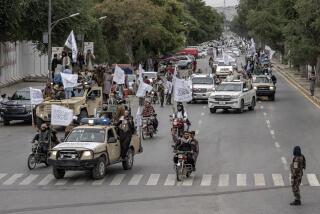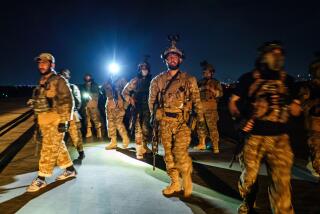Afghan President Forces Foe from Capital : Civil war: Two days of fierce fighting may have broken a lethal, 6-month-old stalemate in Kabul.
- Share via
NEW DELHI — The army of Afghan President Burhanuddin Rabbani, backed by aerial bombardments, artillery and rocket barrages, scored a signal victory Sunday by driving the forces of one of his main foes out of the country’s capital, reports said.
Although no one was predicting an end to the country’s civil war, which has now lasted for a decade and a half, the two days of fierce fighting in Kabul may have broken a lethal, 6-month-old stalemate in Afghanistan’s most important city.
“God is great!” Rabbani’s men shouted, pumping their fists in the air as the magnitude of their victory became clear.
At dawn Saturday, presidential forces launched an air and ground offensive to push back militia loyal to former Communist Gen. Abdul Rashid Dostum and fighters from the Hezb-i-Islami fundamentalist faction led by the rebel prime minister, Gulbuddin Hekmatyar.
Since full-scale warfare broke out in Kabul on New Year’s Day, the two anti-Rabbani leaders had failed to gain much ground, but remained masters of the hills in southern Kabul and subjected the city to unrelenting rocket bombardment.
Gen. Haji Fahiam, the head of national security, told reporters in Kabul that air strikes, rocket attacks and a ground assault on Sunday had succeeded in finally dislodging Dostum’s forces from a strategic location, Marunjan Hill.
Troops loyal to the president also stormed the second important outpost that had remained in Dostum’s hands, a group of Soviet-built apartment buildings in eastern Kabul.
Another strategic spot held by Dostum’s forces, the ancient Bala Hissar fort in southeastern Kabul, was bombed from the air and fell to Rabbani’s fighters on the first day of the campaign. Its ruins were still smoking Sunday.
Five SU-22 and MIG-21 fighters roared over Kabul from Rabbani’s main air base at Bagram, 25 miles north of the capital, to attack Marunjan Hill. A day earlier, more than 20 jets blasted Bala Hissar in the most intense air bombardment Kabul had seen in 15 years of civil war.
Hospitals reported to local journalists that at least 20 people were killed and 130 wounded in the two-day engagement. But since many dead and wounded in Afghanistan’s fighting are never taken to a hospital, the total number of casualties was uncertain.
In the face of such daunting firepower, many of Dostum’s fighters fled, leaving behind weapons, ammunition, food and several armored vehicles and tanks.
Rabbani’s victory appeared to have reduced Dostum’s presence to a minimum in Kabul, though he is still a force to be reckoned with in Afghanistan’s north. In a reported act of retaliation for the humiliation suffered in the capital, jets from Dostum’s bases in northern Afghanistan dropped eight bombs on the center of Herat, 370 miles west of Kabul, on Saturday, killing 10 people and injuring 70.
“All targets and casualties were civilians. The U.N. should take note of this,” a U.N. official quoted Gov. Ismail Khan as saying.
More than 2,000 people have been killed since Hekmatyar and Dostum joined forces Jan. 1 to try to oust Rabbani. At least 20,000 people have been wounded, and a third of Kabul’s 1.5 million residents have fled as rival leaders battled. The Muslim factions formed an uneasy coalition to fight the 1979-89 Soviet occupation of Afghanistan and to topple the Soviet-backed Communist government in Kabul in April, 1992, then began fighting each other.
Reports from Kabul said that Rabbani’s government decided on the weekend assault to preempt a similar strike ostensibly being planned by Hekmatyar and his allies. Rabbani’s term in office expires Tuesday, but he has refused to go if there is no agreement on a successor. Hekmatyar, meanwhile, has said there will be more bloodletting if his foe does not quit as scheduled.
More to Read
Sign up for Essential California
The most important California stories and recommendations in your inbox every morning.
You may occasionally receive promotional content from the Los Angeles Times.













